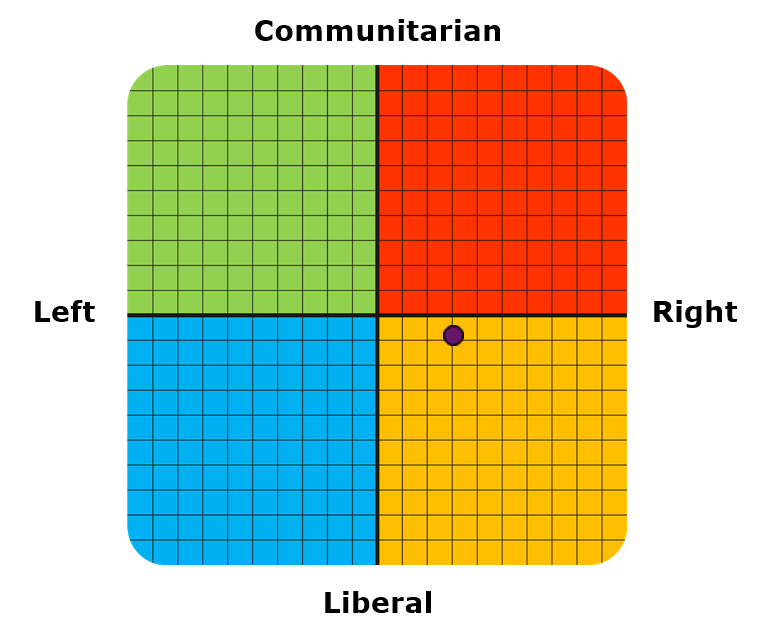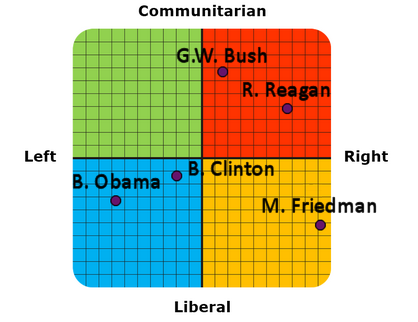Individual Differences Research Labs tells me I'm "30.6 percent Right-leaning, 8.3 percent Liberal (as opposed to Communitarian ... tho they later clarify that 'communitarianism' is also known as "Conservativism") Leaning."
... So I'm as 'Right-Leaning' as George W. Bush and as 'Liberal-Leaning' as Bill J. Clinton ...
 |
| (a morph of Dubya & Bill) |
'Leanings' (below-hyperlinked to I.D.R.'s political-position test) is built on an even-deeper source ... something crucial that firms the foundation upon which our lexicon stands ...
The word |Leaning| (|Inclination, Tendency, to Favor or -Lean toward Mentally) is built on ancient words that mean “to Lean” (I know, 'obviously, right?'
(but that's the meaning of the "proto-root" that's also the root of parts of the words |Clemency, Client, Climate, Climax, Clinic, |Decline, |Ladder, |Lid, |Low (Small |Hill or -Eminence), |Recline).
They explain 'the leanings' (tho I don't know that they ever use 'that word') this way:
Explanation of Quadrants
Left-liberalism (Social Liberalism): Individuals in this quadrant seek to uphold individual liberty while taxing the market to provide social benefits for those in need. They tend to see themselves as seeking balance between individual liberty and social justice, and to be in favor of multiculturalism, secular government, and international cooperation. While they are typically skeptical of state involvement in social affairs, they nevertheless see a legitimate role for the state in combating discrimination and ensuring equal treatment.
Right-communitarianism (Conservatism): Individuals in this quadrant seek to retain the traditional social and economic order and to uphold the sovereignty of the state. They tend to see themselves as the defenders of what their forebears would have wanted, favoring strict immigration laws, traditional values, and a strong military. While they typically see a role for the state in matters of national security and culture, they tend to be more skeptical of state involvement in the economy.
Left-communitarianism (Social Democracy): Individuals in this quadrant seek to promote communal solutions to both social and economic problems. They tend to see themselves as supporting a mode of government that curbs the excesses of capitalism and diminishes inequality by virtue of a mixed economy and a universal welfare state. They seek to encourage collective solutions, economic redistribution and shared values throughout society by means of participatory democracy and the state.
Right-liberalism (Libertarianism): Individuals in this quadrant seek to uphold liberty as the primary political good in all respects. They tend to see themselves as staunch supporters of both personal and economic freedom and are deeply skeptical of collective plans and goals, stressing instead the principle of voluntary association and the individual’s capacity to make his own judgments. They typically see less of a role for the state than individuals in the other three quadrants, believing instead in the spontaneous social order of the market.
Theory and Approach
The Horizontal Axis: Left-Right
In our test, the Left-Right Axis is used as a measure of the respondent's economic views, with the Left favoring state intervention and economic regulation while the Right favors economic freedom and laissez-faire. This means that the Left tends to support state efforts to restrain what they see as the unfair or immoral aspects of the free market while the Right tends to think that transactions between private parties should in principle be free from government interference.
However, a scale covering the respondent's stance on economic issues is not sufficient to explain the considerable variation that is seen within the two groups. Hence we introduce a second axis.
The Vertical Axis: Communitarian-Liberal
All liberals start from the belief that upholding individual liberties is more important than catering to the needs of society. Left Liberals tend to argue that the individual cannot make use of his or her formal liberties without some measure of education and material comfort. In their view, this necessitates redistribution from rich to poor. By contrast, Right Liberals tend to argue that taxing an individual against his will in order to provide welfare benefits to others constitutes an act of coercion and thus a breach of individual liberty. They may support charity and aid for the poor, but they prefer it to be voluntary.
All communitarians start from the belief that the well-being of the community should come before the idiosyncratic desires of specific individuals. Right Communitarians tend to take what might be called a paternal view of politics, favoring a hierarchical society and taking a stern view of threats where criminals belong in prison and foreign powers are deterred by a strong defense. For their part, while the ideologues among the Left tend to hold liberal values, research has tended to point to a sizable segment of voters who combine a left-leaning view of economics with support for the more traditional values of their community and a skeptical view of immigration (Mudde 2013).
Weaknesses and Limitations
Our test is designed to cover the mainstream of political opinions as found within contemporary Western democracies. This means that our test has trouble accommodating extreme or niche opinions like anarcho-syndicalism, anarcho-capitalism, orthodox socialism, and fascism. While there are political coordinates tests in existence that purport to cover this whole range of opinions within the relatively simple quadrants set up by our scheme, the practical consequences (such as plotting centrist democratic leaders a stone's throw from Hitler and Kim Jong Un) seem to confuse more than inform.
Another issue is that, while both of the axes are equally important in theory, the realities of parliamentary politics tend to show that in practice alliances are rarely formed across the Left-Right divide. Although Liberals and Communitarians should in principle be able to form alliances against their counterparts, this almost never happens in actual politics. Hence, while the Left-Right axis has often been said to be antiquated, it nevertheless remains the single most important scale in American and European politics.
References
Mudde, C.: 'Three decades of populist radical right parties in Western Europe: So what?' European Journal of Political Research Volume 52, Issue 1, January 2013
Know anything else interesting about that? Comment!


Comments
Post a Comment
I appreciate your comment, and I'll probably approve it & publish it soon (give me about a week before you try to post it again when it doesn't publish immediately ... thanks)